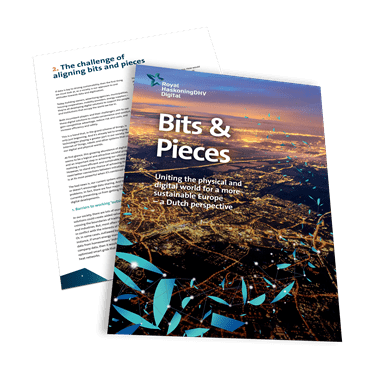Scaling up technology for good
3 digital tech-focused sustainability initiatives that could change the world

Exponential population growth and the ever-increasing demand for food, water, electricity and housing are putting more and more pressure on our natural resources every year. At the current rate of consumption, we’re using 1.75x the resources the earth provides us. And that’s a situation that’s clearly not sustainable.
To help address this issue, government bodies and private organisations are turning to data and technology to help find sustainable solutions to our needs and wants. Here are three examples of small-scale projects with large-scale potential – as long as they’re supported by the right digital infrastructure.
To help address this issue, government bodies and private organisations are turning to data and technology to help find sustainable solutions to our needs and wants. Here are three examples of small-scale projects with large-scale potential – as long as they’re supported by the right digital infrastructure.
Key take-aways
2. Why indoor farming could be the future of food
3. How data can be used to keep our waterways clean
Replacing fossil fuels with solar
In California’s Mojave Desert, over 400 mirrors direct highly-concentrated sunlight at a control tower, which converts it into ultra-high temperature heat of up to 1,500°C.This is Heliogen’s array of ‘heliostats’, a mirror array that’s designed to produce completely carbon-free process heat for industrial applications, such as cement and steel production.
The company, which recently won FastCompany’s 2020 World Changing Ideas award for energy, uses machine vision to constantly adjust the heliostats’ position, ensuring they’re always collecting the optimum amount of solar energy. The heat can even be used to thermo-chemically split water for 100% green hydrogen.
With this project now reaching commercial viability, its leaders are aiming to provide a sustainable, cost-efficient alternative to fossil fuel use in industry.
But to make this leap from proof of concept to go-to resource, the distribution networks and usage models need to evolve alongside innovations like these, increasingly using the power of data to maximise the impact.
Growing food sustainably – indoors
One of the major concerns with a rapidly growing population is how to feed everyone sustainably.More than a quarter of greenhouse gas emissions are currently produced by food production – from crops and livestock farming to the supply chain that ultimately delivers food to the table. And with urban centres expanding, the distance from farm to plate is getting further by the year.
The ‘agtech’ movement, which includes Berlin-based startup Infarm, is looking to change that. Infarm is a pioneer of indoor vertical farming, which uses stackable hydroponic units to grow food anywhere – even in supermarkets themselves – reducing the distance food has to travel by up to 90%.
Each ‘farm’ is controlled via a cloud-based platform connected to IoT sensors within the units, which monitor light, nutrients, temperature and other conditions to ensure optimal growth.
This method uses 95% less water than traditional farming and, with its largest unit able to grow 680,000 plants annually in less than 25 square metres, is 240x more efficient.
However, for this approach to scale – or for farming to become more digital overall – there will need to be a major shift in agriculture, including the widespread adoption of digital technologies like machine vision and IoT sensors.
Reducing plastic pollution in water
Every day, around 8 million pieces of plastic pollution end up in the world’s oceans, with as much as 80% of that pollution comes from litter in rivers.Plastic pollution has a dramatic effect on wildlife, environments and even the food we eat, with one in three fish caught for human consumption now found to contain microplastics.
The Great Bubble Barrier is a Dutch invention that’s designed to help collect plastic waste in rivers and waterways, preventing it from ever reaching the sea.
It’s a perforated tube that runs along the riverbed, using compressed air to create a barrier of bubbles which, when combined with the natural current, diverts litter towards a collector at the side of the waterway.
That plastic can then be disposed of away from the waterways – or even recycled for further use. Additionally, as The Great Bubble Barrier isn’t a physical barrier, it won’t disrupt fish and other wildlife, or get in the way of boats or swimmers.
The first barrier was installed in the Westerdok canal in Amsterdam in late 2019, for a three-year pilot project. Once completed, the creators plan to expand rapidly, with a particular focus on Asia, which is home to eight of the world’s most-polluted rivers.
Initiatives like these can be a great source of data for wider-scale sustainability efforts. By analysing the kinds of plastic collected by the barrier, and using information about currents and river flows, researchers can look further into how and where to focus their efforts to reduce littering and plastic use.
Widespread success requires widespread collaboration
These initiatives – and others like them – have major potential to make a significant difference to our world and environment. But they won’t be able to have the sweeping impact required to solve our sustainability challenges without widespread adoption of the digital infrastructure and data capabilities that enable them.To make that happen, there needs to be a social change as well as a technological one. From individual organisations, universities and research projects, all the way up to governing bodies, groups will need to learn to work together across industries and disciplines to make modern sustainability efforts successful.
In our national digital twin white paper, industry experts Ben Lomax Thorpe and Jaron Weishut lay out the step-by-step approach necessary for digital transformation in Europe, highlighting the importance of multi-level collaboration and the role of digital twins in our long-term success.
White paper
National digital twin: bits & pieces white paper
For an in-depth look at the technologies behind a more sustainable tomorrow, read the full paper.

Stayupdated
Keeping up to date with the latest digital twin news? We've got you covered
